Gregory A. Fournier's Blog, page 15
August 21, 2019
How Hollywood Movie Posters Evolved
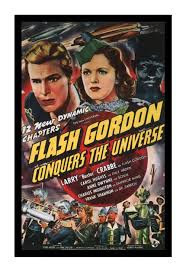 Since the motion picture industry's infancy in the nineteenth century, posters and billboards were the centerpiece of the studios' advertising campaigns. The first movie posters were simple outside placards listing the program being shown inside auditoriums, nickelodeons, and other public venues. The name of the film, the producer, and the director were listed. There were no movie stars yet. These handbills were distributed on the streets and posted outside businesses or wherever there was foot traffic to incite awareness and generate hype to sell movie tickets.
Since the motion picture industry's infancy in the nineteenth century, posters and billboards were the centerpiece of the studios' advertising campaigns. The first movie posters were simple outside placards listing the program being shown inside auditoriums, nickelodeons, and other public venues. The name of the film, the producer, and the director were listed. There were no movie stars yet. These handbills were distributed on the streets and posted outside businesses or wherever there was foot traffic to incite awareness and generate hype to sell movie tickets.The first movie poster was created in 1890 by French painter and lithographer Jules Cheret for "Projections Artistiques." In early Hollywood, playbills began illustrating a film's scene or an array of overlaid images from several scenes. Ordinarily, they contained a basic image and text with the film title in large lettering, sometimes with a tag line. Soon, actors' names were added to the posters.
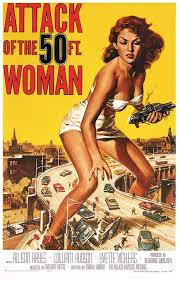 The illustrators were most often anonymous and did not sign their work. They were hired as studio staff. Prior to the 1990s, illustrations instead of photographs were far more common. Today's movie posters contain a billing block in small print at the bottom which includes an array of licensing and consumer information.
The illustrators were most often anonymous and did not sign their work. They were hired as studio staff. Prior to the 1990s, illustrations instead of photographs were far more common. Today's movie posters contain a billing block in small print at the bottom which includes an array of licensing and consumer information.Today, movie poster images are used on websites, DVD packaging, magazine ads, and movie databases. They can hint at the plot, highlight the stars, or offer an abstract representation of a key moment in the film.
Between 1940 and 1984, film posters were exclusively made and distributed by the National Screen Service. The advertising traveled with the film canisters from one exhibitor to the next. At the end of the film's run, the posters were returned with the film canisters and pretty beat up. Few survive intact. In the 1980s, the American film studios took over the direct production and distribution of their poster advertising and began to license the sale of poster reprints for fans. These have little or no value to collectors.
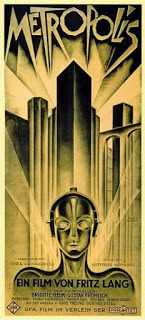 The first movie poster auction by a major house occurred on December 11, 1999. Today, original artwork and vintage posters command huge prices. The record price paid for a single poster was $690,000 for Fritz Lang's 1927 film Metropolis, far more than the original film cost to make.
The first movie poster auction by a major house occurred on December 11, 1999. Today, original artwork and vintage posters command huge prices. The record price paid for a single poster was $690,000 for Fritz Lang's 1927 film Metropolis, far more than the original film cost to make.Nine decades of movie posters are depicted with a brief explanation of trends for each decade. There are many fan favorites shown.
http://creativeoverflow.net/the-90-year-evolution-of-movie-posters/
Published on August 21, 2019 07:18
August 16, 2019
Terror In Ypsilanti--House of Mystery/NBC Radio August 15, 2019
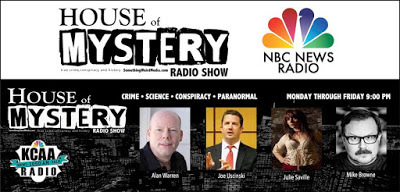
Thank you to the House of Mystery for interviewing me (August 15, 2019) about my true crime book Terror In Ypsilanti and Michigan serial killer John Norman Collins.
The interview occurs 20 minutes into the program and runs for about 25 minutes. The Detroit Fox 2 News feature is in three segments--each with its own link.
Terror In Ypsilanti Los Angeles Radio Interview--August 2019
Detroit Fox 2 News feature about the Washtenaw County Murders--September 2019
Published on August 16, 2019 08:14
July 31, 2019
Antoine Cadillac--Detroit's First Godfather
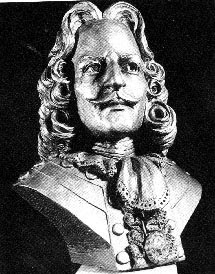 Bust of Antoine de la Mothe CadillacAn expedition financed by the French monarch--King Louis XIV--and promoted by his Minister of Marine--Comte de Pontchartrain--appointed Antoine de la Mothe Cadillac as their agent to establish a fur trading post and fort in New France. In return, Cadillac was granted generous riverfront real estate. He envisioned a permanent French colony controlling the fur trade routes through the upper Great Lakes, with him at the helm.
Bust of Antoine de la Mothe CadillacAn expedition financed by the French monarch--King Louis XIV--and promoted by his Minister of Marine--Comte de Pontchartrain--appointed Antoine de la Mothe Cadillac as their agent to establish a fur trading post and fort in New France. In return, Cadillac was granted generous riverfront real estate. He envisioned a permanent French colony controlling the fur trade routes through the upper Great Lakes, with him at the helm.Commander Antoine Cadillac led a fleet of 25 large canoes--with 50 soldiers, 50 empire builders, 2 Roman Catholic priests, and his 11-year-old son--on a 52 day trip westward from French-controlled Montreal to the western bank of a swift running river that connected Lac Erie with Lac St. Clair.

This site was chosen because it was the narrowest point of the strait--de troit--which is how Detroit earned its name. There was an eroded 40' clay bluff leading up from the river bank to a flat clearing. Once a fort was built on the plain, anything moving up or down the river could be seen and was in easy range of their cannons. This was a defensible position to discourage the British and control the fur trade.
The empire builders arrived on July 23, 1701 and began work on a log fort Cadillac named after his benefactor--French Minister of Marine--Comte de Pontchartrain. Two days later, a mass was said in honor of Ste. Anne--the patron saint of France and mother of the Virgin Mary. After the service, the foundations for the church were laid. Catholicism had come to the wilderness.
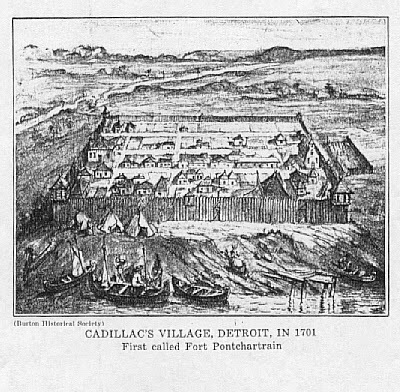
Fort Pontchartrain contained a warehouse which doubled as a store. There were also two guard houses, Ste. Anne's Church, and about 15 houses within the fort. Lots could be no larger than 25 square feet and some were smaller.
In a report about Detroit to his superior officers, Cadillac noted, "Especially attractive was the region that lies south of the pear-like lake to which they gave the name of St. Clair, and the country bordering upon that deep, clear river, a quarter of a league broad, known as Le Detroit.
"On both sides of this strait lie fine, open plains where the deer roam in graceful herds, where bear, by no means fierce and exceedingly good to eat, are to be found, as are also the savory poules d'Indies (wild duck) and other varieties of game. The islands are covered with trees; chestnuts, walnuts, apples, and plums abound; and in season, the wild vines are heavy with grapes.
"Le Detroit is the real center of the lake country--the gateway to the West. It is from there that we can best hold the English in check."
French trade with the local Native American tribes went well for the most part. Cadillac encouraged the Ottawa, Huron, Pottawatomie, Miami, and Wyandotte tribes to cluster together in villages near the fort for protection from their mutual enemies--the Iroquois and the British. In total, Cadillac estimated that there were about 2,000 Indians in and around Fort Pontchartrain allied with the French.
In 1702, the first European baby born in Detroit was the daughter of Alphonse de Tonty--Cadillac's second-in-command--and his wife. Not to be outdone--in 1704--the Cadillac's gave birth to Marie Therese, who became the first recorded baptism christened in Ste. Anne's Church registry.
Cadillac wanted the settlement to grow rapidly, but few if any unattached women were available to single men, so he proposed that christened Indian women be allowed to marry French settlers. The Jesuit priest strongly objected on moral and religious grounds, and the plan was soon rejected. This is likely the first official instance of discrimination in Detroit's long history.
 In 1707, Cadillac began issuing farm grants--known as ribbon farms--to attract new settlers. These farms ranged from 200' to 1,000' wide and extended from the shoreline for 2 or 3 miles. Each farm had waterfront access. Many of Detroit's current street names derive from the original ribbon farm grant holders--for instance--Beaubien, Campau, Livernois, Riopell, Dequindre, and others. Cadillac plotted out 68 parcels.
In 1707, Cadillac began issuing farm grants--known as ribbon farms--to attract new settlers. These farms ranged from 200' to 1,000' wide and extended from the shoreline for 2 or 3 miles. Each farm had waterfront access. Many of Detroit's current street names derive from the original ribbon farm grant holders--for instance--Beaubien, Campau, Livernois, Riopell, Dequindre, and others. Cadillac plotted out 68 parcels. Cadillac acted like a feudal landlord requiring farmers to pay him an annual rent and a percentage of their grain to use the windmill he had built on the waterfront north of the fort. He was the mill's sole proprietor and could charge whatever he wanted. Renters were also required to work on Cadillac's farm for a specified number of days each year.
To engage in any kind of trade, settlers had to pay a licensing fee and annual taxes. Cadillac grew rich by padding the fees and taxes and skimming off the top. When he withheld the allotment of imported brandy behind padlocked warehouse doors, it was discovered--and reported--that he was trading it to the Indians for beaver pelts. He had defied a Royal decree not to provide liquor to the native population.
When complaints about Cadillac reached Montreal and Paris, King's Deputy Francois Clarembault went to survey Detroit area holdings in 1708 and found they did not match Cadillac's reports. After nineteen days in Detroit, Clarembault returned to Canada and sent his findings off to France. In 1709, Count Pontchartrain wrote to Cadillac complaining that he showed "too much greed and little moderation in his dealings with the settlers."
In 1710, Cadillac was called to Quebec to answer charges against him brought by his detractors. He was acquitted of extortion and abuse of power charges but was removed from his post--never to return to Detroit. The following year, Cadillac was promoted to the governorship of the Louisiana Territory.
Published on July 31, 2019 07:31
July 23, 2019
Fox 2 News Retrospective of Ypsilanti's Co-Ed Murders
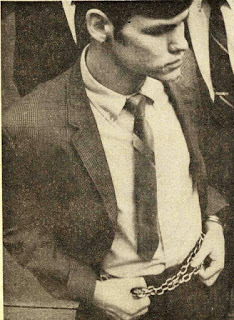 John Norman Collins--1970If you missed Detroit Fox 2 News investigative reporter Rob Wolcheck's retrospective on the fifty years since the Ypsilanti Co-Ed Murders of 1967 through 1969, Monday night's news feature is linked below.
John Norman Collins--1970If you missed Detroit Fox 2 News investigative reporter Rob Wolcheck's retrospective on the fifty years since the Ypsilanti Co-Ed Murders of 1967 through 1969, Monday night's news feature is linked below. This feature story is told over three nights. I'll add Tuesday and Wednesday's segments as I capture the internet links. For your convenience, you'll be able to access them all in this post.
Part one: Fox 2 News--Ypsilanti Co-Ed Murders 1967-1969
Part two: Who is John Norman Collins?
Part three:
Published on July 23, 2019 06:14
July 14, 2019
The 1928 Delray Murder of Sportsman Gus Nykiel
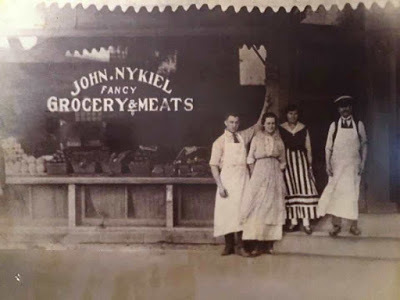 A young Gus Nykiel next to his sister Martha. Their father John is wearing a hat. The woman in the striped dress is an unknown employee. They are standing in front of the family grocery store located at 8800 West Jefferson Ave. which became Joey's Stables named for Gus's youngest brother.
A young Gus Nykiel next to his sister Martha. Their father John is wearing a hat. The woman in the striped dress is an unknown employee. They are standing in front of the family grocery store located at 8800 West Jefferson Ave. which became Joey's Stables named for Gus's youngest brother.August "Gus" Nykiel (pronounced Nickel) was a popular local Detriot athlete who played semi-professional football for a team called The Delray Merchants almost one hundred years ago. The team's name was changed to the Detroit Tigers football franchise, but it failed after its first season with the National Professional League in 1921. Nykiel decided to sponsor the team which became a semi-professional powerhouse keeping the name. They played semi-pro clubs from around Michigan and the Midwest. The Tigers became regional champions and were the team to beat for several years. Nykiel became a popular, sporting world figure who had a sport's field named after him.
Gus Nykiel began his rum-running career shortly after Prohibition began. First, Gus and his three brothers--William, Frank, and Joseph--used a rowboat and made several trips a day hauling liquor and beer to the downriver area. The Nykiel brothers eventually built a fleet of speed boats and became some of the wealthiest bootleggers on the river. Gus and his brothers had ties to the Purple Gang's downriver distribution network.
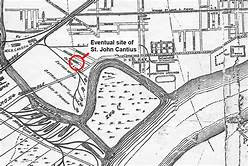 Delray, Zug Island, the Detroit River, and the Rouge River.
Delray, Zug Island, the Detroit River, and the Rouge River.Delray lies across the Zug Island channel and the Rouge River where boats could be unloaded and powerboats could evade Coast Guard patrol boats on the Detroit River. It was an ideal place to smuggle liquor. If a boat had to toss its load, burlap bags full with liquor bottles were tied with loops called rabbit ears. When the coast was clear, smugglers would come back with a grappling hook and retrieve their goods. Sometimes, local Delray and River Rouge boys would watch the evening gun battles between customs agents and smugglers from the shoreline. They would remember where the loads were ditched--usually near or on shallow sandbars. When the danger passed, the boys would dive in and retrieve what they could often selling the Canadian whiskey back to bootleggers.
***
On March 17, 1927, saloon owner Gus Nykiel was arraigned in federal court for reopening his saloon at 8631 West Jefferson Avenue which had been closed and padlocked on federal court order. Several undercover Prohibition officers made buys which resulted in the raid. Large quantities of beer, whiskey, and wine were seized. Nykiel was said to be the owner of four other places where liquor was stored and distributed: 8866 West Jefferson, 465 Clairpoint, 110 Henry Street, and 3021 Fourteenth Street.
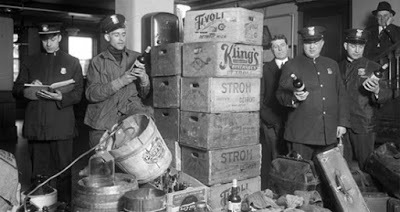
Nykiel was released on $5,000 bail. When his case came to trial, he plead guilty to violating the padlock injunction and owning the property but denied ownership of the liquor. He admitted he knew it was stored in his business. Federal Judge Charles E. Simons fined him $1,000. The owners of the liquor were identified as Sam Kert and Sam "Sammy Purple" Cohen. They were under federal indictment for conspiracy to violate the Prohibition laws. The two Sammies were known mentors and associates of the Purple Gang.
***
Nykiel's saloon was shut down permanently, but within a month, he opened a new location up the street at 8824 West Jefferson. At about 10:00 p.m. on June 27, 1928, Nykiel was parking his car in front of his saloon and scratched the paint of James Zanetti's car. Zanetti was a gunman from Chicago hired to extort money from bootleggers and speakeasy owners in the Downriver area for Pete Licovoli's East Side River Gang.
According to Gus's brother William, Zanetti began verbally abusing Gus, so Gus walked up and punched the out-of-town hood twice in the face. "I'll smack you again if you come around here looking for trouble. Tell your friends that Gus Nykiel hit you." Zanetti and Mike Dipisa--said to be gambler "Jimmy the Greek's" bodyguard--returned fifteen minutes later looking for Gus. The two men went into the saloon and spotted him behind the bar. Dipisa said he wanted to talk to Gus outside.
As soon as Nykiel stepped out the door, he was shot five times at close range and fell to the sidewalk. The shooters ran toward their getaway car. River Rouge Constable Edward A. McPherson happened to be in the saloon serving a summons when he heard the shots. With gun drawn, he stepped outside and exchanged gunfire hitting Dipisa. McPherson--for his pains--was shot in the upper jaw. Passerby, Mrs. Catherine Krozyck, was hit in the hand by a stray bullet.
Nykiel was taken to Delray Receiving Hospital where he died from his wounds. Dipisa was taken to Detroit Receiving Hospital where he died from a shot to the head, the back, and his right eye. When police notified Mrs. Nykiel of her husband's murder, she wept at news. "Gus may have been a bootlegger," she said, "but he was a faithful husband and a good father."
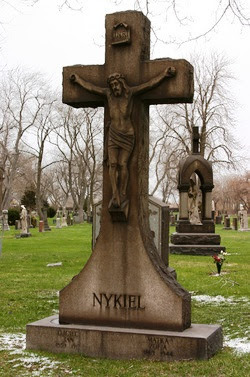 Gus Nykiel's funeral service was July 2, 1928 at St. John Cantius Roman Catholic Church in Delray. He was buried at Holy Cross Cemetery. Thousands of people paid their respects along the procession route to the cemetery. The majority of mourners were women, but underworld figures and police detectives were sprinkled among the crowd.
Gus Nykiel's funeral service was July 2, 1928 at St. John Cantius Roman Catholic Church in Delray. He was buried at Holy Cross Cemetery. Thousands of people paid their respects along the procession route to the cemetery. The majority of mourners were women, but underworld figures and police detectives were sprinkled among the crowd. Gus's younger brother William told Inspector Henry J. Garvin of the crime and bomb squad that he witnessed the shooting. At the inquest, William repeated what he saw. But Garvin thought that the murder was more than a road rage incident. The inspector told reporters he believed the East Side River Gang was trying to seize control of Nykiel's business interests and control smuggling on the Detroit River from Lake St. Clair to Monroe.
James Zanetti was arrested by two police officers after a short car chase and taken to Wayne County Jail. Because he attempted suicide in his cell, Zanetti was admitted to the psychopathic ward of Receiving Hospital, where he was heavily guarded and chained hand and foot to a hospital bed. Nurses reported that at intervals, he would shudder, roll his eyes back in his head, and quiver issuing long, drawn out moans. Psychiatrists believed Zanetti was mentally sick from "crime hysteria" or what was better known on the street as being "yellow." Dr. Polzker believed Zanetti's suicide attempt failed because he didn't have the courage to follow through with it.
The Zanetti trial was slated to begin on August 30th, but the prosecution's primary eyewitness--William Nykiel--could not be found. The case was postponed twice before Detroit police announced on September 8th that their key witness was hiding out for fear of his life in LaSalle, Ontario where they had no jurisdiction to extradite him. The prosecution proceeded without him. On September 13th, James Zanetti was acquitted of Gus Nykiel's murder. After the not guilty verdict was delivered, Zanetti and his lawyers were surrounded by back-slapping and handshaking from their underworld supporters.
For all the wealth Gus Nykiel was rumored to have amassed during his years of rum-running, he left his wife and child an estate worth only $55,000 to pick up the pieces of their shattered lives.
Published on July 14, 2019 08:25
July 2, 2019
In Search of Detroit's Purple Gang
 Photo credit: Don Gutz
Photo credit: Don GutzI just returned from a research trip to the Walter Reuther Library and the Wyandotte Historical Museum to find some local color about Detroit's Purple Gang and the Prohibition era. Finding anything new about this group of Jewish mobsters after almost 100 years is like recovering bootlegged Canadian booze from the bottom of the Detroit River--what hasn't been dredged up already remains buried deep beneath the sand.
Obtaining simple documents like vital records for known Purple Gang members is next to impossible. Descendants of Purple Gangsters--protective or ashamed of their notorious family members--jealously guard their family documents, relics, and photographs. The trauma of losing husbands, brothers, uncles, and fathers to gang warfare and inter-gang disputes reflected badly on a family's reputation within their Jewish community. Their personal stories were not to be talked of in public, with the press, or even with younger family members who were kept in the dark. The less said, the better.
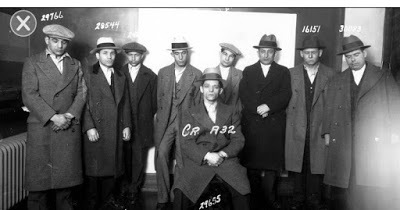 A Purple Gang roundup photo with several predominate members.
A Purple Gang roundup photo with several predominate members.Stories of the gang's early years are the stuff of folklore and their legacy is mythic. What remains of the Purple Gang's real story is sprinkled throughout the pages of vintage 1930s-1940s newspaper articles written in real time as the gang achieved notoriety by becoming the dominant gang in Prohibition Detroit. Once the press gave the gang a name and marquee status, law enforcement went after them with a vengeance.
My nonfiction treatment of the Purple Gang saga is entitled The Elusive Purple Gang--Detroit's Kosher Nostra. It will be a concise history of their rise from juvenile delinquents committing petty street crime to young adults controlling Detroit's rackets during the city's most lawless and deadly period of its history. Rather than assume an academic voice, I chose to take on the voice of a storyteller to attract a popular audience of readers unfamiliar with the Purple Gang's history. The release of the book will coincide with the 100th anniversary of Federal Prohibition in 2020.
The Elusive Purple Gang post: https://fornology.blogspot.com/2018/12/the-elusive-purple-gang.html
Published on July 02, 2019 08:22
June 3, 2019
Literary Classics 2019 Awards Ceremony
 For self-published authors who labor long hours in obscurity, winning a writing award is a cost effective way to gain exposure for your book title. Most competitions include press releases, photo opportunities, book cover medallions, and formal presentation ceremonies.
For self-published authors who labor long hours in obscurity, winning a writing award is a cost effective way to gain exposure for your book title. Most competitions include press releases, photo opportunities, book cover medallions, and formal presentation ceremonies.Winning a writing award competition is a valuable tool for self-published authors to gain media exposure and to network with like-minded individuals who share similar goals and challenges. Scheduled receptions and author forums allow for social opportunities with other writers to share information about our best practices and marketing strategies creating a sense of community for one brief weekend.
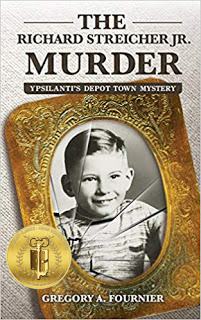 This year's Literary Classics Awards Ceremony occurred on May 12th, 2019 in Rapid City, South Dakota. My book The Richard Streicher Jr. Murder won a silver medallion for adolescent mystery and a gold medallion for true crime.
This year's Literary Classics Awards Ceremony occurred on May 12th, 2019 in Rapid City, South Dakota. My book The Richard Streicher Jr. Murder won a silver medallion for adolescent mystery and a gold medallion for true crime.As an added bonus, my wife and I took a side trip to Mt. Rushmore and the Crazy Horse Memorial to make our trip a three-day weekend vacation. Both attractions are truly wonderous and awesome to see.
If you haven't entered a writing contest, you might want to give it a try. Winning is a great motivator.
Link to my Amazon author site.
Published on June 03, 2019 10:01
May 23, 2019
Brave New World of Betty Boop
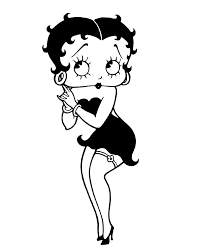 Classic Betty Boop Sketch
Classic Betty Boop SketchBetty Boop was a music novelty character who was a sex symbol during the Great Depression. She was a caricature of Roaring Twenties flappers--young women who smoked cigarettes, drank alcohol, drove cars, and danced the Charleston in speakeasies. Betty Boop became known as the "Boop-Oop-a-Doop girl." Her personality can best be described as moxie.
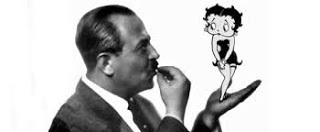 Max Fleischer with his creation.Betty was a creation of Max Fleischer Studios targeted for an adult movie audience during the 1930s. She wore short dresses, high heels, garters, and contoured necklines. Betty's "innocent sexuality" was a mixture of girlish naivete and vampish allure which some people would define as infantilizing women.
Max Fleischer with his creation.Betty was a creation of Max Fleischer Studios targeted for an adult movie audience during the 1930s. She wore short dresses, high heels, garters, and contoured necklines. Betty's "innocent sexuality" was a mixture of girlish naivete and vampish allure which some people would define as infantilizing women.In 1932, jazz singer Cab Calloway performed in the famous film short "Minnie the Moocher" singing that evocation song while the video blended into a Betty Boop animation defining her character and making her a star. This musical short was one of the original music videos and the song became Calloway's signature theme song for subsequent stage appearances.
As Betty's popularity progressed, many of her early cartoons found Betty fighting off predatory men trying to compromise her virtue, making some modern American women view her as a feminist icon against sexual harassment. By 1934, the Hayes Production Code forced animators to tame the Boop character by making her a ambitious career girl trying to make it in the big city. She began wearing appropriate business attire and less jewelry. The newer cartoons lost their edge and their popularity--the last of the original cartoons was made in 1939. The Betty Boop series gained a new audience when her cartoons were released for television making Betty an American cartoon superstar.
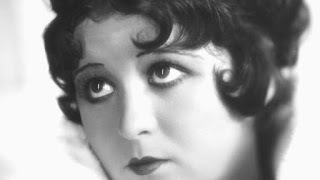 Helen KaneBetty's "baby talk" voice was similar to the voice characterization of actress Helen Kane whose musical comedy stage career had faded by 1931. Kane brought a $250,000 infringement lawsuit in 1934 against Paramount Pictures for "deliberate caricature exploiting her personality and image."
Helen KaneBetty's "baby talk" voice was similar to the voice characterization of actress Helen Kane whose musical comedy stage career had faded by 1931. Kane brought a $250,000 infringement lawsuit in 1934 against Paramount Pictures for "deliberate caricature exploiting her personality and image."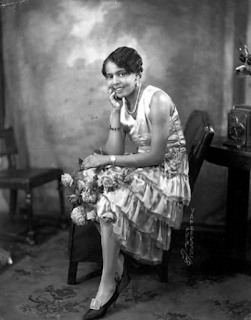 Esther JonesDuring the trial, it was discovered that African American cabaret performer Baby Esther (Esther Jones) used a similar vocal style in her Harlem Cotton Club act. Even the scat "Boop-Opp-A-Doo" was created by Jones as a vocal jazz improvisation. An early jazz novelty short film was found featuring Baby Esther performing her "baby talk" style. The New York Supreme Court ruled that the "baby talk" technique did not originate with Kane.
Esther JonesDuring the trial, it was discovered that African American cabaret performer Baby Esther (Esther Jones) used a similar vocal style in her Harlem Cotton Club act. Even the scat "Boop-Opp-A-Doo" was created by Jones as a vocal jazz improvisation. An early jazz novelty short film was found featuring Baby Esther performing her "baby talk" style. The New York Supreme Court ruled that the "baby talk" technique did not originate with Kane.  Six different actresses portrayed the voice of Betty Boop. Two of them--Margie Hines and Mae Quistal were also the voice of Olive Oyl in the Popeye cartoons of the same era.
Six different actresses portrayed the voice of Betty Boop. Two of them--Margie Hines and Mae Quistal were also the voice of Olive Oyl in the Popeye cartoons of the same era. Although the series ended in 1939, Betty's character appeared in two television specials in the 1980s, and she made a cameo appearance in the feature movie Who Shot Roger Rabbit? in 1988. Her image is still popular worldwide and has become a merchandising goldmine for King Features Syndicate.
Link to "Minnie the Moocher"
Published on May 23, 2019 16:09
May 5, 2019
The Purple Gang Tied Up In Chains
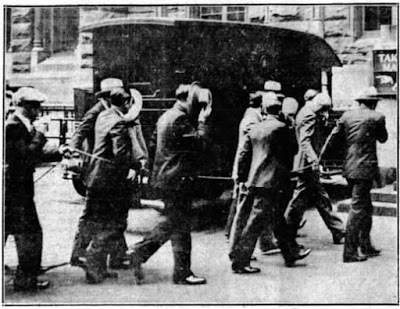
A decisive federal arrest of four Purple Gang members marks a change in the public attitude towards Detroit's most notorious Prohibition-era gang. Prior to their arrest on May 24, 1929, members of the Purple Gang were often arrested, arraigned, and released before beating whatever rap they were accused of. The public believed that the gang was prosecution proof. There was lots of evidence to support that belief.
But this time was different. The gang wasn't dealing with the Detroit or Wayne Country court system. Conspiring to violate the prohibition law was a federal offense and twelve known Purple gang members were rounded up. Federal Judge Charles C. Simons levied bail of $100,000 each against Eddie Fletcher, Abe Axler, Irving Milberg, and Harry Sutton--the four men caught in the act. The other eight "associates" were held on $50,000 bail apiece.
For the first time in the gang's history, the city's professional bail bondsmen couldn't post bail for that sum of money. The official blanket charge was that on May 10, 1929, the Purple Gang "entered into a conspiracy with Canadian liquor exporters to purchase and import beer and liquor. Known gang members delivered two cases of whiskey to the Lido Club, a cabaret on 3747 Woodward Avenue owned by Abe Burnstein said to be the leader of the Purple Gang."
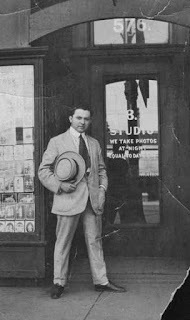 Burnstein could not be reached for comment. Abe was attending a crime conference in Atlantic City--the first of its kind. Crime bosses from around the country attended and made decisions like a corporation would that affected the direction of organized crime in America. This was where the modern mob was born. But Abe's youngest brother Izzy was among the men arrested.
Burnstein could not be reached for comment. Abe was attending a crime conference in Atlantic City--the first of its kind. Crime bosses from around the country attended and made decisions like a corporation would that affected the direction of organized crime in America. This was where the modern mob was born. But Abe's youngest brother Izzy was among the men arrested.The boys had to cool their heels in the Wayne County Jail. Their faces fell when they saw the U.S. Marshall approach them with a length of chain and six pairs of handcuffs welded to it. The twelve men were cuffed together in tandem along either side of the chain leaving one had free so they could hide their faces on their perp walk. Then they were led to the Marshall's van for a ride to the Wayne County Jail.
All but four of the men were released on writs of habeas corpus for lack of evidence. Fletcher, Axler, Milberg, and Sutton were held over for trial. Two months later, they reappeared in federal court each ten pounds trimmer. Apparently, County Jail food didn't agree with them. All four were convicted and charged the maximum sentence--twenty-four months in federal prison and a $50,000 fine each. They were credited with two months for time served. Finally, the Purple Gang myth of immunity from prosecution was broken.
The Elusive Purple Gang
Published on May 05, 2019 15:52
May 1, 2019
Eastern Michigan University Student Queried - "Is Paul (McCartney) Dead?"
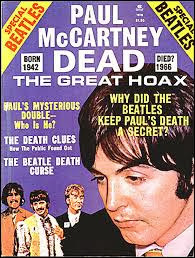 The biggest hoax in the history of Rock & Roll is surely the "Is Paul Dead?" controversy. On Sunday afternoon, October 12, 1969, Thomas Zarski, an Eastern Michigan University student, called [Uncle Russ] Gibb, a concert promoter and popular D.J. for Detroit's underground music radio station - WKNR-FM.
The biggest hoax in the history of Rock & Roll is surely the "Is Paul Dead?" controversy. On Sunday afternoon, October 12, 1969, Thomas Zarski, an Eastern Michigan University student, called [Uncle Russ] Gibb, a concert promoter and popular D.J. for Detroit's underground music radio station - WKNR-FM.On the air, Zarski asked Gibb what he knew about the death of Paul McCartney. This was the first the D.J. heard of it. "Have you ever played "Revolution 9" from the The White Album backwards?" Zarski asked.
Gibb hadn't. Skeptical, he humored his call-in listener and played the song backwards. For the first time his audience heard, "Turn me on, dead man." Then WKNR's phone started ringing off the hook.
Apparently, the rumor started when Tim Harper wrote an article on September 17, 1969 in the Drake University (Iowa) newspaper. The story circulated by word of mouth through the counter culture underground for a month until Zarski caught wind of it. He called Uncle Russ asking about it. Gibb had solid connections with the local Detroit and British rock scene because he was a concert promoter at the Grande Ballroom--Detroit's rock Mecca.
University of Michigan student Fred LaBour heard the October 12th radio broadcast and published an article two days later in the October 14th edition of The Michigan Daily as a record review parody of the Beatles' latest album Abbey Road. This article was credited for giving the story legs and was the key exposure that propelled the hoax nationally and internationally.
The legend goes that Paul died in November of 1966 in a car crash. The three categories of clues were:
Clues found on the album covers and liner sleeve notes,Clues found playing the records forward, and Clues found playing the records backwards.The clues came from the albums:
Yesterday and Today,Sergeant Pepper's Lonely Hearts Club Band,Magical Mystery Tour,The Beatles [the White Album], andAbbey Road.Some people thought the Beatles masterminded the hoax because of the large number of clues. They thought there were too many for this story to be merely coincidental.
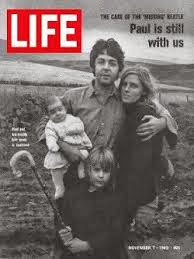 The story peaked in America on November 7th, 1969, when Life magazine ran an interview with Paul McCartney at his farm in Scotland, debunking the myth.
The story peaked in America on November 7th, 1969, when Life magazine ran an interview with Paul McCartney at his farm in Scotland, debunking the myth. For more detailed information on the myth and the clues, check out these links:
http://turnmeondeadman.com/the-paul-is-dead-rumor/
http://keenerpodcast.com/?page_id=602
Video link: http://www.youtube.com/watch?v=xqBf6iNPVOg
Published on May 01, 2019 07:13



